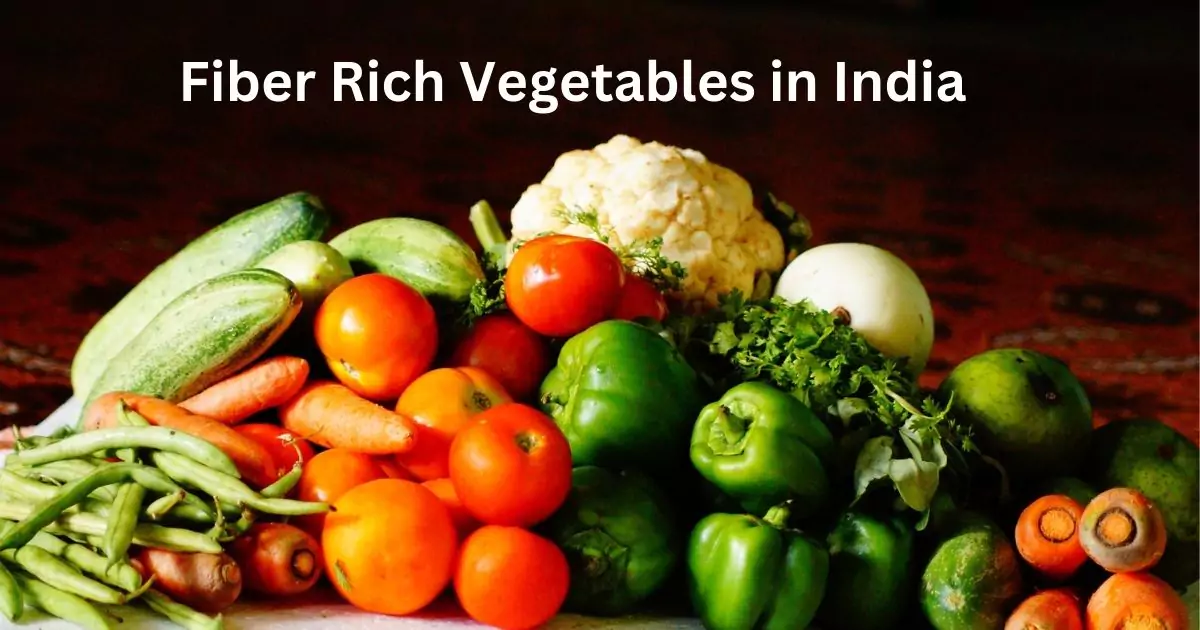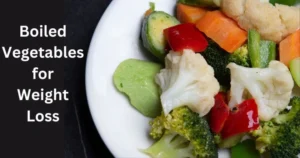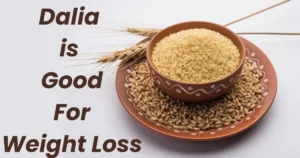Introduction
This article explores the top fiber rich vegetables in India, their health benefits, and easy ways to incorporate them into your regular diet. Fiber is a vital nutrient that supports a healthy digestive system, promotes heart health, and helps you feel fuller for longer.
Incorporating fiber-rich vegetables is a simple and effective way to boost overall health and well-being. In India, a wide variety of vegetables are naturally rich in dietary fiber; these foods help improve digestion, lower cholesterol levels, and regulate blood sugar levels.
Whether you’re new to healthy eating or looking to diversify your meals, these vegetables will help you achieve your health goals.
Fiber Rich Vegetables in India are a treasure of nutrition, which helps maintain a healthy gut and balanced diet, often found in every household kitchen. Known for boosting metabolism and supporting weight management, these vegetables provide numerous health benefits.
Read More: Difference between chia seeds and basil seeds
Why Fiber Matters for Your Health
Dietary fiber, found in plant-based foods, is a carbohydrate that comes in two types: soluble and insoluble. Soluble fiber dissolves in water, forming a gel-like substance that helps lower cholesterol and stabilize blood sugar. Insoluble fiber adds bulk to stool, promoting regular bowel movements and preventing constipation.
Research says Dietary fibre is beneficial to health and, if consumed in adequate amounts, reduces the risk of several chronic diseases, such as Cardiovascular Disease, type II diabetes, obesity, and certain types of cancer, while supporting digestive health.
According to the Indian Dietetic Association, it’s mentioned that Adults should aim for at least 30g of fibre daily from a variety of plant sources in order to attain various physiological benefits. Adding fiber-rich vegetables to your meals can bridge this gap, offering benefits like:
- Improved Bowel function: Fiber promotes regular bowel movements and prevents digestive issues like constipation.
- Heart Health: High intake of Dietary fiber reduces cholesterol levels, lowers blood pressure, and reduces the risk of heart disease.
- Blood Sugar Control: Fiber slows glucose absorption, helping manage diabetes or prevent it.
- Weight Management: High-fiber foods keep you full, reducing overeating and supporting weight loss.
Top Fiber Rich Vegetables in India
About 30–40% of the dietary Fiber in the human diet comes from vegetables. India’s rich culinary tradition includes a variety of vegetables that are both flavorful and packed with fiber.
Below are some of the best fiber rich vegetables in India, which you can easily find and incorporate into your diet.
1. Okra (Bhindi)
Okra, known as bhindi in India, is a versatile vegetable. The fruit of okra contains both soluble and insoluble fiber. It’s also loaded with vitamin C, vitamin K, and zinc.
One cup (100 grams) of okra provides about 3.2 grams of fiber. Its mucilaginous texture aids digestion and supports gut health. High fiber content in okra makes you feel full for longer.
Okra is a staple in Indian cuisine, often used in curries, stir-fries, or as a crispy snack in bhindi masala.
How to Use: Sauté okra with spices like cumin and turmeric for a quick sabzi. Pair it with whole wheat roti for a fiber-packed meal.
2. Spinach (Palak)
Spinach, or palak, is a nutrient-dense leafy green that delivers approximately 2.2 grams of fiber per cup (100 grams). It’s rich in iron, calcium, vitamins A, C, and K, making it a powerhouse for overall health.
Spinach is high in insoluble fiber, which may support digestion, add bulk to stool, and support the movement as food passes through your digestive system.
This may help improve bowel-related health problems, such as constipation, hemorrhoids, and fecal incontinence (problems controlling your bowel movements).
How to Use: Add spinach to dals, curries, soups, or smoothies. Try making palak paneer or a spinach paratha for a delicious, fiber-rich dish.
3. Carrots (Gajar)
Carrots are crunchy, vibrant vegetables that offer about 4.4 grams of fiber per 100 grams of carrots. They’re rich in both soluble and insoluble fiber, supporting digestion, bowel motility, and satiety.
Carrots are packed with beta-carotene, which promotes eye health, significantly improves night vision, and boosts immunity. In India, carrots are a staple in salads, curries, and desserts like gajar ka halwa.
How to Use: Enjoy raw carrots as a snack with hummus or add them to soups, stir-fries, or pulao for extra crunch and nutrition.
4. Sweet Potatoes (Shakarkandi)
Sweet potatoes are a nutritious root vegetable. 100 grams of baked sweet potato with skin provides about 3.3 grams of fiber.
They are a mixture of both soluble and insoluble fiber. The soluble fiber, which can lower cholesterol and balance glucose, and the insoluble fiber, which helps keep your bowels healthy and regular.
Sweet potatoes also help improve the balance of your gut bacteria and overall gut health, which supports your digestive system.
Sweet potatoes are also rich in vitamin A and antioxidants, making them great for skin health and boosting immunity.
How to Use: Roast sweet potatoes with spices or mash them for a side dish. You can also use them in curries or as a base for healthy chaat.
5. Green Peas (Matar)
Green peas are a fiber and protein powerhouse, offering about 8.8 grams of fiber per cup (160 grams) of cooked peas according to the USDA. They contain soluble and insoluble fiber both with insoluble fiber on the higher side.
These fibers add bulk to stool, promote gut health, stabilize blood sugar, and keep gut bacteria healthy.
In India, peas are commonly used in pulao, curries, and snacks like matar kachori.
How to Use: Add green peas to rice dishes, soups, or stir-fries. Try a matar paneer curry for a fiber-rich vegetarian meal.
6. Cauliflower (Gobi)
Cauliflower offers about 2 grams of fiber per cup (100 grams) and is a low-calorie, versatile vegetable. It is loaded with soluble and insoluble fiber.
It adds bulk to stool and promotes bowel regularity, supports digestion, promotes fullness, and provides vitamin C. Cauliflower supports overall digestive and gut health.
In India, cauliflower is a favorite in dishes like gobi matar or aloo gobi.
How to Use: Roast cauliflower with Indian spices or use it to make a low-carb cauliflower rice for pulao.
7. Beetroot (Chukandar)
Beetroot contains about 1.8 grams of fiber in half a cup of beets. Both soluble and insoluble fiber are present.
While its fiber supports digestion, Beets are good sources of antioxidants, vitamins, and minerals, such as folate, manganese, potassium, iron, and vitamin C.
Beetroot is used in Indian salads, juices, and curries.
How to Use: Grate beetroot for salads, roast it for a side dish, or blend it into a healthy smoothie.
How to Incorporate Fiber-Rich Vegetables into Your Diet
Adding fiber-rich vegetables to your meals is easy and delicious. Here are beginner-friendly tips to get started:
- Start with Breakfast: Include a bowl of mixed seasonal vegetable salads. Or blend spinach or carrots into a morning smoothie or make a vegetable-stuffed paratha.
- Mid-morning Snack: Munch on raw carrots, baked sweet potatoes, or roasted chickpeas for a fiber-packed snack.
- Lunch: Pair vegetables with whole grains like brown rice or whole wheat roti to boost fiber intake.
- Add to Curries and Dals: Incorporate okra, peas, or spinach into your favorite Indian curries or lentil dishes.
- Evening Snacks: Try new dishes like broccoli stir-fry or sweet potato chaat to keep meals exciting.
- Dinner: Add mixed vegetable soups or lightly sautéed veggies to your dinner. Or you can also mix grated carrots, cucumbers, or beets into parathas and upma.
Make sure at least one-third of your plate is filled with colorful vegetables for maximum fiber intake and balanced nutrition.
Potential Side Effects and How to Avoid Them
While fiber is essential, increasing intake too quickly can cause bloating, gas, or abdominal discomfort. To avoid these issues:
- Increase Gradually: Start with small portions of fiber-rich vegetables and gradually increase over a few weeks.
- Stay Hydrated: Drink 8-10 glasses of water daily to help fiber move through your digestive system.
- Balance Your Diet: Combine fiber-rich vegetables with lean proteins and healthy fats for a well-balanced diet.
- Slightly Cook: You can slightly cook the vegetables for easy digestion and prevent bloating.
Consult a doctor if you have specific digestive concerns or are on medication, as fiber can affect nutrient absorption.
Meal Planning Tips for Beginners
Planning meals helps ensure you meet your fiber goals. Here’s a simple plan for a day:
- Breakfast: Oatmeal with spinach and a sliced apple.
- Lunch: Whole wheat roti with okra sabzi and a side of carrot salad.
- Snack: Roasted chickpeas or raw beetroot sticks with yogurt dip.
- Dinner: Brown rice with green pea curry and a mixed vegetable soup.
This plan provides 32-39 grams of fiber, meeting or exceeding daily recommendations.
Why Choose Indian Vegetables for Fiber?
Indian vegetables are not only rich in fiber but also affordable, making them an excellent choice for everyday meals. These vegetables fit seamlessly into everyday meals and are easily absorbed, and come with additional nutrients like vitamins, minerals, and antioxidants.
These vegetables not only improve digestion and support weight management but also offer taste, nutrition, and health in every bite. Their vibrant flavors and versatility make it easy for beginners to enjoy healthy eating without feeling overwhelmed.
Conclusion
Fiber rich vegetables in India, like okra, spinach, carrots, sweet potatoes, green peas, broccoli, cauliflower, and beetroot, are excellent additions to a beginner’s diet in India. The diets with high content of fibre have been reported to have a positive effect on health.
They support digestion, heart health, blood sugar control, and weight management while adding variety to your meals. Start small, experiment with recipes, and gradually increase your fiber intake to enjoy the benefits.
These vibrant vegetables not only nourish your body but also savor the rich flavors of Indian cuisine. Begin your journey today by adding one or two of these veggies to your next meal!
FAQ’s
1. Can fiber rich foods help with weight loss?
Several Studies have shown that eating fibre rich foods significantly reduces the risk of gaining weight and fat in the body.
2. Are there any side effects of consuming too much fiber?
Consuming too much fiber may cause bloating or abdominal discomfort; hence, water should be consumed adequately to keep yourself hydrated throughout the day.
3. Can fiber help with constipation?
Yes, insoluble fiber adds bulk to stool and regulates bowel movement, which can help prevent constipation.
4. Can fiber help control blood sugar?
Yes, Soluble dietary Fibre delays the digestion and absorption of blood glucose into the bloodstream, thereby helping control blood sugar levels.
5. How much fiber should I eat daily?
In Adults, at least 30 grams of fiber is recommended to eat daily.
References
Fiber Content of Selected Vegetables
Health Benefits of Sweet Potatoes
https://www.webmd.com/diet/health-benefits-sweet-potatoes
Sweet potato, cooked, baked in skin, flesh, without salt
https://fdc.nal.usda.gov/food-details/168483/nutrients
DIETARY FIBRE AND HEALTH
https://idaindia.com/wp-content/uploads/2018/12/IDA-position-paper-fibre-24.12.18.pdf
Diversity of fibers in common foods: Key to advancing dietary research
Dietary Fiber
https://iffgd.org/manage-your-health/diet-and-treatments/dietary-fiber/
Dietary fibre in foods: a review
Dietary fiber: Essential for a healthy diet




